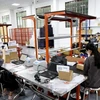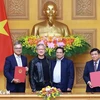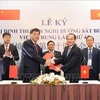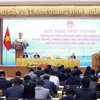 A milk production line of the NUTIFOOD Binh Duong Food Joint Stock Company in Binh Duong Province.(Photo: VNA)
A milk production line of the NUTIFOOD Binh Duong Food Joint Stock Company in Binh Duong Province.(Photo: VNA)Hanoi (VNA) - The State should eliminate price ceilings for milk products and control milk prices via input materials instead, experts said.
Price ceilings were put in place in May 2014 by the Ministry of Finance. At the end of the second quarter of 2015, the ministry extended the price ceiling through the end of this year.
The Ministry of Finance’s Pricing Management Department said after stabilising milk prices, the prices dropped by between 0.1 percent and 34 percent for milk products for under six year-olds.
Nguyen Anh Tuan, Director of Ministry of Finance’s Price Management Department, told Tin tuc (News) newspaper early this week that the price ceiling would be effective until the end of this year and then the ministry would review the price ceilings.
Nguyen Thi Xuan, a Hanoi resident, said the current price for a 900g can of Nan milk is 340,000 VND , while it was 400,000 VND before the price ceiling was enforced.
She worried that if the State eliminated the price ceiling the price of milk products for children would increase again.
Meanwhile, Phuong Thao, owner of a milk shop in HCM City said before the price ceilings, milk producers and distributors had adjusted their prices according to supply and demand on the market and explained the reasons for the adjustments.
Since the price ceiling was enacted, companies had offered less discounts and promotions for agencies and customers when they adjusted milk prices, she said.
Vu Ngoc Quynh, General Secretary of the Vietnam Dairy Association, said in the short term, buyers have enjoyed lower prices thanks to the price ceiling.
But in the mid and long term, the mechanism would hinder the development of milk products and reduce competition among producers, said Quynh.
Price expert Ngo Tri Long said the mechanism discouraged companies from investing in production of new products and gave no incentive to improve product quality. That also made the companies unable to compete at home and abroad.
The State should abolish the price ceilings and let the market decide the prices, Long said. To control milk prices without the price ceiling, the State should manage the import of materials for the production of milk products by using the tax and customs policies.
He also said that it would be difficult to increase the prices of milk products for under six year-olds after eliminating the price ceiling because dairy companies must register the new prices and get approval from the State to adjust their prices.
Nutrition and Food Group under Eurocham represented six foreign multi-national dairy companies in Vietnam proposing that the State should remove the price ceiling and use the market to determine prices.
To ensure cheap milk powder products, the State should reduce import tax and value-added tax for the components of these products. The import tax for milk is 5 percent for products from ASEAN and 10 percent for products from other countries.-VNA




















